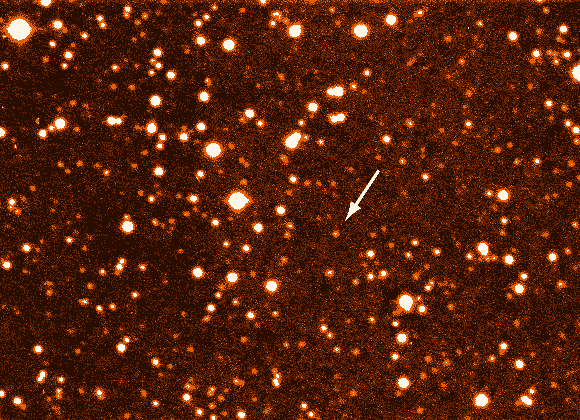Skip to comments.
Astronomy Picture of the Day 10-09-02
NASA ^
| 10-09-02
| Robert Nemiroff and Jerry Bonnell
Posted on 10/09/2002 1:28:25 PM PDT by petuniasevan
Astronomy Picture of the Day
Discover the cosmos! Each day a different image or photograph of our fascinating universe is featured, along with a brief explanation written by a professional astronomer.
2002 October 9

Quaoar: Large Asteroid in the Outer Solar System
Credit: Chad Trujillo & Michael Brown (Caltech)
Explanation: Asteroids almost as large as planets are still being discovered in our own Solar System. Recently an asteroid more than half the size of Pluto was found orbiting at a distance only a little further than the Solar System's most distant planet. The large asteroid moves relative to background stars in the discovery images shown above taken by the Oschin Telescope at Palomar, California, USA. Quaoar, the name suggested for the space rock by its discoverers, is one of several large asteroids discovered recently that roam in the distant Kuiper Belt. Quaoar's size was resolved by images from the Hubble Space Telescope. Quaoar is likely a cold world covered in ice from which the Sun appears only as a particularly bright star.
TOPICS: Astronomy; Astronomy Picture of the Day; Science
KEYWORDS: asteroid; astronomy; discovery; hubble; image; kuiperbelt; newobject; observatory; orbit; palomar; photography; quaoar; solarsystem; telescope
Astronomy Fun Fact:NEW DISCOVERY! They gave a provisional name to the asteroid, "Quaoar" (pronounced kwah-o-wahr). It's a word for the creation force in the Tongva (San Gabrieliños) tribe of Southern California. Also called Mission Indians. Anyway, as with many objects in the solar system, the asteroid was given a name from mythology. Unfortunately, it is tricky to pronounce, and looks way too much like "quasar". The name Quaoar is not the official name until the International Astronomical Union (IAU) votes on it. They don't usually turn down a discoverer's choice, though. Its provisional designation is 2002 LM60.
Refresh the page to see the GIF image animation again.
To: MozartLover; Joan912; NovemberCharlie; snowfox; Dawgsquat; viligantcitizen; theDentist; ...
To: petuniasevan
Thanks friend!!
To: petuniasevan
Is Percival Lowell still alive to see this?
To: petuniasevan
In the old days of astronomy, when astronomers actually looked through telescopes, they would stay up all night tracking by hand for long-exposure photographs through telescopes, and then stay up all day looking through blink comparators hoping to spot moving objects such as this. Once they found one, they would attempt to track it for a while until they could get three separated position readings and apparent angular velocities and then stay up all weekend calculating orbits with 7-place log tables. Modern astronomers hardly ever look through telescopes, and they don't have to stay up all night in an unheated dome. Astronomers were a different breed.
To: petuniasevan
Cool! I just read an article in the paper about this and it's nice to see a picture of it.
6
posted on
10/09/2002 4:33:17 PM PDT
by
altair
To: petuniasevan
Movin' and groovin' for heavens' sake bump !! 
To: petuniasevan
Thanks!
To: petuniasevan
bump
To: petuniasevan
Great picture of a planet killer! Good job APOD!
Disclaimer:
Opinions posted on Free Republic are those of the individual
posters and do not necessarily represent the opinion of Free Republic or its
management. All materials posted herein are protected by copyright law and the
exemption for fair use of copyrighted works.
FreeRepublic.com is powered by software copyright 2000-2008 John Robinson

